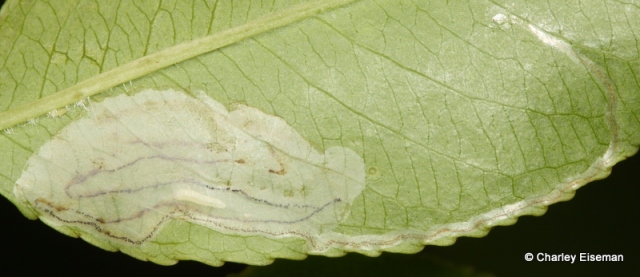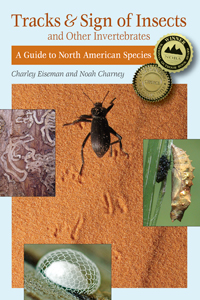Last night I finished revising and updating the Lepidoptera chapter for the second edition of Leafminers of North America, and when I got to the end I was reminded that some species of Leucania (like the ill-fated one I wrote about earlier this month) start out life mining in blades of grass. Yes, even big ol’ noctuids can be leafminers. There’s no escaping them.
Anyway, it’s been nearly a week since my last post, and in the meantime several more miners have appeared in my yard.
#12: Marmara fraxinicola (Gracillariidae). On May 22, Julia and I were cutting some saplings from the edges of the yard for use in our new tomato infrastructure, and at the top of a 15-foot white ash (Oleaceae: Fraxinus americana) sapling was this fresh-looking stem mine:


It can often be difficult to trace a Marmara mine from beginning to end, but because this mine was made recently and because this species mines throughout its development in the outermost layer of bark, following this one was a piece of cake.
The transparent shell of the egg that was deposited early last summer is visible at one end…

…and the yellowish larva, still feeding away in the bark, is visible at the other end.

It’s admittedly harder to see than the larva of a leafminer, but it’s there all right, in the upper left corner of the above photo. This is actually within 2 cm of the eggshell, but on the other side of the branch. Over the past ten months or so, the larva mined 22 cm toward the tip of the branch, then turned around and mined 20.5 cm back down. The branch is currently sitting in a vase on the kitchen counter where I can keep an eye on it. I’ve never tried to rear this species before, but it is one that, like Marmara viburnella, spins its cocoon under a bark flap excised at the end of the mine, so I don’t have to worry about the larva wandering off or drowning in the water in the vase.
The next three species came in the form of adult beetles, and since I wasn’t carrying a camera when I saw them, I’ll illustrate them with photos from past years.
#13: Orchestes pallicornis (Curculionidae). On May 23 I spotted this weevil nibbling on a leaf of black cherry (Rosaceae: Prunus serotina) at the edge of the yard.

Like Dibolia borealis, this flea weevil has a single generation per year, with larvae feeding in spring or early summer and with adults overwintering. Soon, females will be inserting eggs along the midribs of leaves, and the larvae will form linear mines extending toward the leaf tips.

Older larvae form blotch mines and then spin circular cocoons in which to pupate. Here is a communal mine with three cocoons inside:

#14: Chalepus walshii (Chrysomelidae). Yesterday morning when I went to pick some pokeweed shoots for lunch, I found an adult of this beetle perched at the tip of a blade of reed canary grass (Poaceae: Phalaris arundinacea).

A few inches below it was one of the characteristic rectangular feeding patches I illustrated here. This is another species that has a single generation and overwinters as an adult, but C. walshii larvae can be found later in the season than those of D. borealis and O. pallicornis. Reed canary grass wasn’t known to be a larval host of C. walshii until I found some mines in my yard last July and reared a couple of adults from them.

This is immediately recognizable as a Chalepus mine because of the characteristic brown egg covering near the tip of the leaf, as well as the dark brown frass expelled from the leaf margin.
#15: Brachys aerosus (Buprestidae). Yesterday afternoon I spotted this species nibbling on the edge of a red oak (Fagaceae: Quercus rubra) leaf.

Once again, this is a leaf-mining beetle with a single generation per year, but Brachys species overwinter as larvae within their mines rather than as adults. They pupate once the weather warms up, and the adults emerge about a month later. Eggs are laid in summer, but the larvae take their time, and they can still be found feeding in late October, as in this example (the larva is at far right):

In contrast, the Aulagromyza cornigera larva that appeared on May 18 had already exited its mine when I checked on May 22:


On May 23, I went to check on the Caloptilia serotinella larva I’d found two days earlier. It had crossed the midrib, but otherwise hadn’t made much progress.

Actually, looking at the photo now, I can see that the larva crossed back over the midrib and exited through a hole in the epidermis just below the midrib, to the left of the frass line. So it turns out this species will sometimes make an entirely linear mine, rather than the linear-blotch mines I usually see.
In any case, as I arrived at that black cherry sapling, the wind happened to blow a neighboring leaf in such a way that I noticed a similar mine that was only visible from the lower surface.

I believe this is another C. serotinella mine. Some Caloptilia species aren’t particular about which side of the leaf they mine.
The next day, silk spun by that larva within the blotch portion of the mine had caused the mine to buckle and become “tentiform.”

And once again, now that I look at the photo on the big screen, I can see the larva had already exited at this point—the hole is at the far left end. But not having noticed this yet, I went back one more time yesterday to check on the mine’s progress, and the leaf had now completely folded over, concealing the blotch.

Having seen these exit holes, I had to dash out into my yard just now—flushing a gorgeous male indigo bunting from the dandelions by the front door—and verify that yes, the larvae have now formed neighboring leaves into conical shelters in which to complete their feeding, as Caloptilia larvae should.

I think we’re all caught up now, in terms of leafminer happenings in my yard… Meanwhile, I’ve partaken of another four edible plants from the yard since last time:
51. Common milkweed (Apocynaceae: Asclepias syriaca) – shoots
52. Riverbank grape (Vitaceae: Vitis riparia) – leaves
53. Wild leek (Amaryllidaceae: Allium tricoccum) – leaves
54. Pokeweed (Phytolaccaceae: Phytolacca americana) – shoots
Just in case anyone reading these posts is inspired to go out and try the plants I’ve been listing: please do some research first! The shoots of both milkweed and pokeweed, for instance, require boiling for seven minutes or so before eating, or you’ll be sorry. I’d never tried pokeweed before, but it turns out to be delicious, as advertised—somewhat similar to asparagus. Milkweed is also quite good, and don’t worry, there is plenty left for the monarchs, and the milkweed tussock moths, and the large and small milkweed bugs, and the milkweed long-horned beetles, and the milkweed weevils, and the milkweed leaf-mining flies—all of which are equally deserving of our affection and it drives me nuts when people want to kill or remove any non-monarch organism they find on their milkweed plants. If you simply refrain from mowing your lawn, you will soon have more than enough milkweed to suit everybody’s needs. We got enough from weeding a few strawberry and asparagus patches yesterday to provide the main vegetable for last night’s stir fry and this morning’s omelet, and new shoots keep popping up faster than we can pick them.



And cutting milkweed makes it more palatable to monarchs (regrowing shoots are better than older ones – a group here in MI is advocating cutting in summer for monarchs). So I bet you are doing them a service by cutting shoots.
Pingback: The Yard List(s), Part 8 | BugTracks
Thanks for the loud voice for all the milkweed loving insects!!! 😃
Pingback: The Yard List(s), Part 10 | BugTracks
Pingback: The Yard List(s), Part 14 | BugTracks
Pingback: The Yard List(s), Part 17 | BugTracks
Pingback: The Yard List(s), Part 18 | BugTracks
Pingback: The Yard List(s), Part 23 | BugTracks